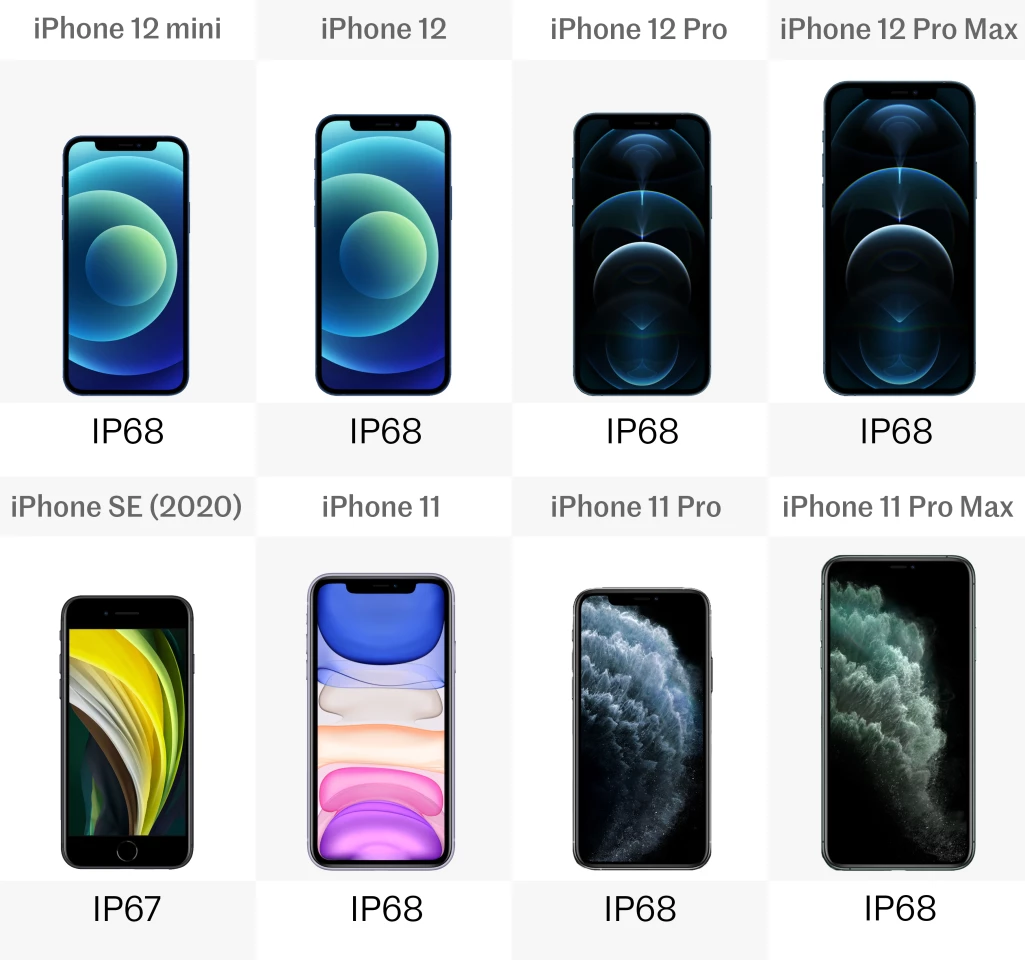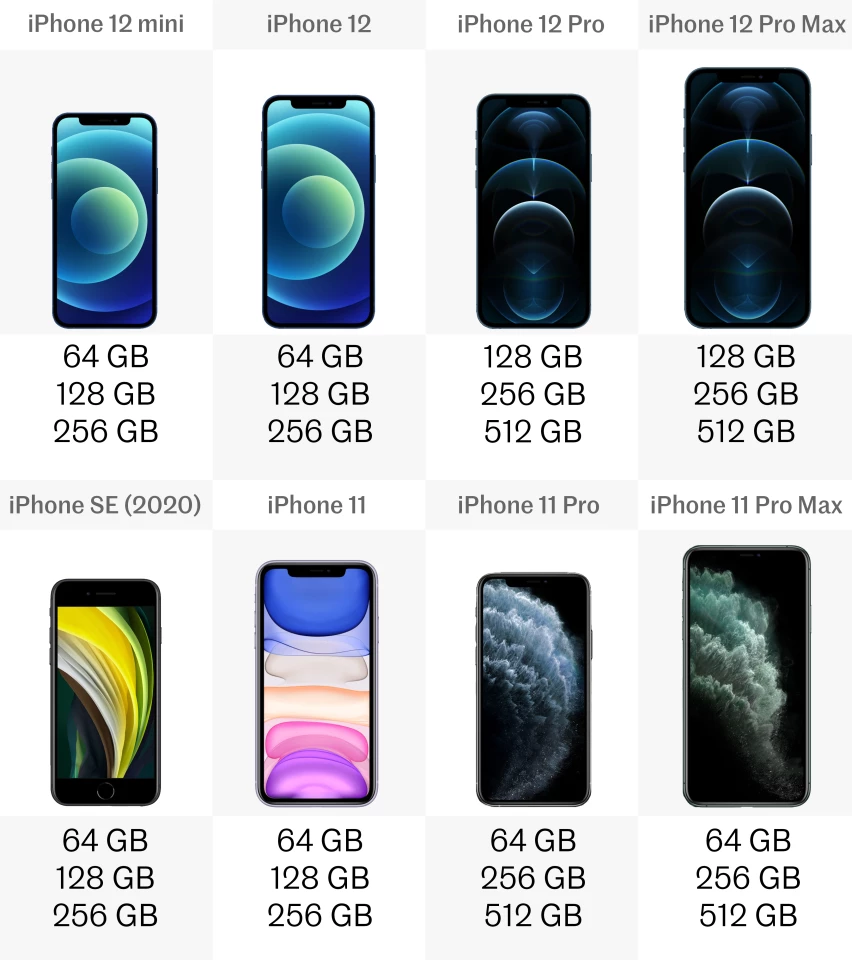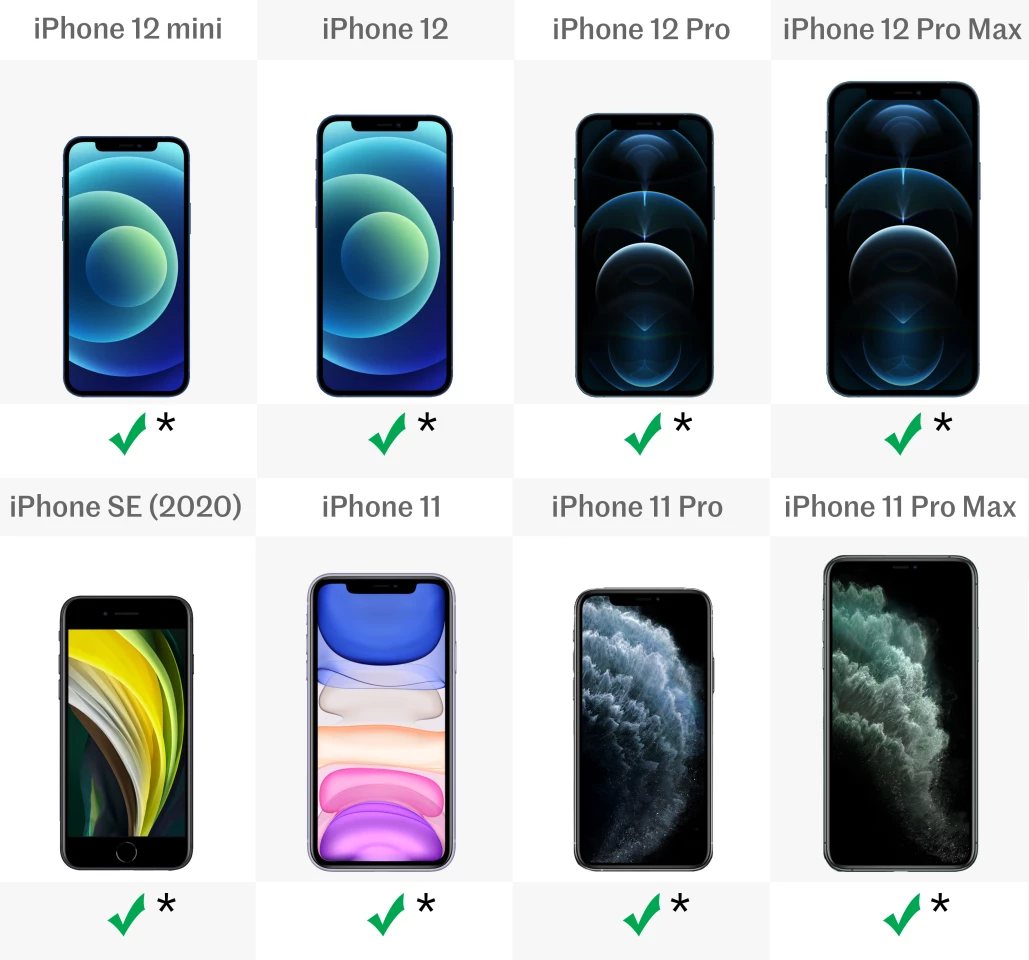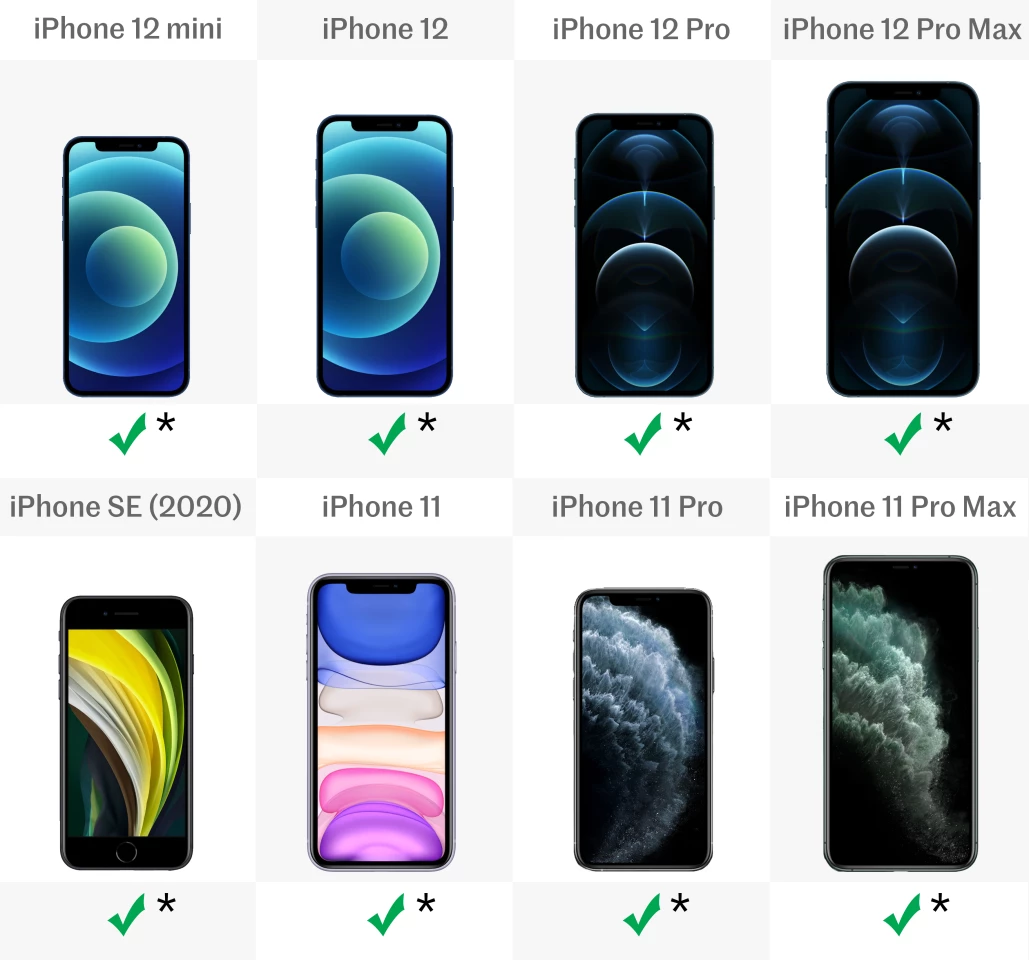After a bit of a delay, Apple has shown off this year’s iPhone 12 models. But are they worth the upgrade? New Atlas compares the specs and features of the iPhone 12 mini, iPhone 12, 12 Pro and 12 Pro Max against the iPhone SE, iPhone 11, 11 Pro and 11 Pro Max.
This year there are four iPhone 12 models – following last year’s naming conventions, there’s a base model, a Pro and a Pro Max version. But for the first time there’s now also a mini model as well, with the main difference being the physical size.
Even though Apple has now stopped directly selling the 11 Pro and Pro Max, we’ve included them in this comparison because they’re still easily bought from other vendors. And of course, it may help those who already own these models and are wondering if it’s worth the upgrade. The second generation iPhone SE is here too, because it’s still a viable option having only released earlier this year.Size

Generally, each of the iPhone 12 models is slightly bigger than its 11 counterpart. The iPhone 12 and 12 Pro are the exact same size in all dimensions, which is just a few millimeters bigger than the 11 Pro. Likewise, the 12 Pro Max is a few mm bigger than the 11 Pro Max.
The opposite is true for the 12 mini though – it’s a bit smaller than the SE, but that’s kind of the point. This is a phone for those who are sick of the ever-growing “phablets” weighing down their pockets.
And finally, the base model 11 is kind of left floating in the middle on its own. It’s a little bigger than the 12 and 12 Pro but a far cry short of both generation’s Pro Max models.Weight

The iPhone 12 mini is the lightest of the bunch, at just 135 grams (4.8 oz), while the heaviest is the 12 Pro Max at 228 g (8 oz). That’s a difference of 93 g (3.2 oz) across the whole range, which is the equivalent of more than 18 nickels. Weight isn’t the most important factor to consider but when the difference is like lugging around a pocketful of change, it’s worth keeping in mind.Colors

As a rule, Apple seems to give its lower end models brighter and more playful colors, while the premium iPhones get more muted metallic finishes. As such, black, white and red are common to the iPhones SE, 11, 12 and 12 mini. The latter two get green and blue options, while the 11 also comes in green, yellow and purple.
The Pro and Pro Max models, meanwhile, all come in gold and silver finishes, with the 11s also offering Space Gray and Midnight Green and the 12s getting Graphite and Pacific Blue.Materials

All eight of these iPhones are made with glass front and back, ringed with a metal. On the iPhone SE, 11, 12 and 12 mini that’s aluminum, and on the Pro and Pro Max models that frame is stainless steel.
New to the iPhone 12 lineup is what Apple calls a “ceramic shield.” The display is made with a newly-developed glass ceramic, which is designed to make the screen up to four times more resistant to breaking. The iPhone 12 series is also equipped with magnets that attach to new accessories like wallets, cases and chargers. Display size

The iPhone SE is packing the smallest screen, at a quaint 4.7 inches. Next in line is the 12 mini, which despite being a physically smaller device still squeezes in a 5.4-in screen. The 11 Pro is next, followed by a three-way tie between the 11, the 12 and 12 Pro, on 6.1 in.
The iPhone 11 Pro Max packs a respectable 6.5-in display, but the 12 Pro Max tops them all with a huge 6.7-incher.Screen-to-body ratio

The iPhone SE has the smallest screen-to-body ratio of the bunch – it’s modeled off the outdated iPhone 8 look, with chunky bezels and thick strips across the top and bottom.
The rest fare better thanks to a notch design in the top that houses the selfie camera. The iPhone 12 series manages to fit a decent amount more screen than any of the 11 phones.Display resolution

The iPhone 12 lineup generally has a higher resolution than their predecessors. In fact, the iPhone SE and 11 are among the last phones to have screens that don’t even reach Full HD resolution – a standard that most other companies reached years ago. The 11 Pro and Pro Max are much better equipped, with displays that are roughly 2K.
The 12 and 12 Pro have the same screen, which slots in between the 11 Pro and 11 Pro Max. Meanwhile the screen on the 12 Pro Max is the beefiest of the bunch.Display type

After sticking with IPS LCD for years, Apple is now firmly in the OLED camp, like most of its competitors. As such, it now reserves LCD tech for its lower end phones – in this case, the iPhone 11 and SE. Generally speaking, OLED devices should bring brighter colors, deeper blacks and better contrast.Processor

A new generation means a new processor, so the iPhone 12 series is powered by Apple’s latest chipset, the A14 Bionic. As the first to market with a 5-nanometer architecture (most are still at 7 nm), the company brags that this new processor is the fastest in any smartphone ever. That said, the A13 is no slouch either. It’s still up there with the fastest, compared to other devices.RAM

Apple doesn’t officially release its RAM figures, so we usually have to wait for third party teardowns. At this early stage, nobody’s gotten their hands on the iPhone 12s yet, so we’re not sure what the RAM is, but speculation suggests the iPhone 12 and 12 mini are running 4 GB – the same as the 11 lineup – while the 12 Pro and Pro Max boost that to 6 GB.Front camera

The iPhone 12s have the same selfie cam as the 11s – a solid camera with 12 megapixels, and an aperture of f/2.2. They’re also equipped with depth-sensing technology that Apple calls TrueDepth 3D, which is what enables the Face ID facial recognition system.
The iPhone SE misses out however, and is instead kitted out with a non-depth-sensing, 7-MP camera.Rear cameras

Arguably there hasn’t been a huge leap in camera tech this generation – in fact, numbers wise the only real difference is a slightly wider aperture (the f-number) on some cameras.
All eight phones start with a wide-angle, 12 MP camera. Everything bar the SE then adds an ultra-wide angle lens, also with 12 MP. And at the top of the line, the Pro and Pro Max models of the iPhone 11 and 12 round it out with a 12-MP telephoto lens.
The biggest new addition is the LiDAR sensor on the iPhone 12 Pro and Pro Max. Similar to the depth-sensing technology used to help autonomous cars navigate, this should greatly improve things like augmented reality (AR) and bokeh effects.Photo modes

Most of the same camera modes are available across the board here, but the iPhone 12s show some marked improvements in the specifics.
They can all shoot in high dynamic range (HDR), which captures both the brightest and darkest parts of a scene at once. The iPhone 12 series has a new version Apple calls Smart HDR 3, which apparently uses machine learning to recognize what’s in the scene and brighten or darken bits to bring out the best detail.
All eight iPhones can snap panoramas, and have some form of AR, where virtual objects and characters are overlaid on the real world through the camera. It can be used, for example, to catch Pokémon in the park, turn yourself into a cartoon character for a video message, or check how that new couch might look in your living room. As mentioned above, AR is improved on the iPhone 12 series thanks to the LiDAR.
Bokeh also benefits from that tech. This effect, available on all eight phones to some degree, artfully blurs the background to help the subject stand out. It’s clearest in portrait mode, which also allows for different lighting effects to recreate a studio shoot.
Night mode is a nifty trick that can be done on all these phones except the SE. It takes longer exposures to capture more light in darker scenes, illuminating them better without washing out the color or detail. In the iPhone 12s, night mode has been applied to both the wide and ultra-wide cameras, with the wide camera capturing 27 percent more light than previous models. In the 12 Pro and Pro Max, a larger sensor lets even more light in, while the LiDAR helps focus in low light.
The iPhone 12s also have a new feature called Deep Fusion. This captures several exposures in a row then analyzes them to maximize detail at different depths, from foreground to background.
And finally, there’s the zoom. Every phone of the eight has at least five-times digital zoom, with the 11 Pro and Pro Max and the 12 Pro bumping that up to 10 times. The 12 Pro Max goes even further, to 12 times digital zoom.
All models beyond the SE also offer optical zoom. The iPhone 11 Pro and Pro Max and the 12 Pro can zoom in up to two times closer, while the 12 Pro Max can zoom in 2.5 times. All iPhone 11s and 12s can also use their wide angle lenses to zoom out up to two times, to fit more into frame.Video modes

All eight of these iPhones have more or less identical video modes too. They can all shoot in 4K resolution at 24, 30 or 60 frames per second (fps), and in 1080p Full HD at either 30 or 60 fps.
They can capture slow motion videos at either 120 or 240 fps, in Full HD resolution. And they can speed things up with time lapses.
It’s all smoothed out with optical and electronic image stabilization (OIS/EIS), too.
Perhaps the most impressive new feature on the iPhone 12 range is the ability to record in Dolby Vision in real time. This grading technique is usually applied to films in post-production, but the A14 chip can crunch the numbers in order to do it while shooting video. Apparently not even professional movie cameras do that – let alone other phones.Biometrics

The TrueDepth 3D camera can scan a face in three dimensions, which can be used to unlock the phone in a system Apple calls Face ID. The iPhone SE is the only one to lack this feature, and instead it’s kitted out with a fingerprint sensor located on the back.Water resistance

All eight iPhones can shake off a spilled drink or a quick dunk in the pool or bath. The SE has a water resistance rating of IP67, which according to Apple means it can be submerged in 1 m (3.3 ft) of water for up to 30 minutes. For the iPhone 11 series, the IP68 rating extends that to 2 m (6.6 ft) for the same time.
But for the new generation Apple outdoes itself, claiming that the iPhone 12 range can apparently dive all the way down to 6 m (20 ft). Of course, we wouldn’t recommend putting any of these claims to the test with your shiny new iPhone, but at least there’s some peace of mind in case of accident.Built-in storage

All eight of these phones come with three tiers of built-in storage capacity. The iPhone SE, 11, 12 and 12 mini all have 64, 128 and 256 GB options. The iPhone 11 Pro and Pro Max strangely skip the 128 GB versions and add a much higher 512 GB option instead. The iPhone 12 Pro and Pro Max meanwhile drop the 64 GB and add the 128 GB as the smallest option.
Whichever one you choose, make sure it’s enough for your needs because you’ll be stuck with it. Apple traditionally doesn’t offer MicroSD card slots to expand that storage later on.Battery

Like with RAM, Apple doesn’t officially disclose its battery capacity numbers, so again we can’t confirm them. But Apple says that you should get 15 hours of continuous video playback out of the iPhone 12 mini, 17 hours on the 12 and 12 Pro, and 20 hours on the 12 Pro Max. By the same metric the iPhone SE can last 13 hours, the iPhone 11 and 11 Pro last up to 17 hours, and the 11 Pro Max gets 20 hours.Fast charging

All eight of these iPhones can be fast charged, but there’s a catch: Apple is the only company in the game with the gall to ask customers to fork out for a separate fast charger. Everyone else throws it in the box.
The company is starting to improve on this front though. The 11 Pro and Pro Max come with the required 18 W adapter and USB-C-to-Lightning cable, and the 12 lineup has the cable but not the adapter. For the others, you’ll need to buy both the adapter and the faster cable.Wireless charging

Again, all eight iPhones can be wirelessly charged, using proprietary Apple chargers or the industry-standard Qi wireless chargers – but you’ll need to buy those separately as well.
In the iPhone 12 lineup, Apple is also now making new MagSafe wireless chargers, which align themselves using the built-in magnets and can charge the device faster than other wireless chargers.5G

One of the major selling points of the iPhone 12 lineup is the ability to connect to 5G – the new cellular networks that are in the process of rolling out around the world. They should allow internet speeds to clock up much faster than on the existing 4G, which is what you’ll have to settle for on the iPhone SE and 11 series.Ports

Apple’s proprietary Lightning port is the only one left on the bottom of these devices. It’s used for charging or plugging in earbuds, but only the 11 Pro and Pro Max come with the latter. Many see Bluetooth headphones as the way to go nowadays, anyway.Operating system

Being Apple devices, all eight iPhones are of course running on iOS. The iPhone SE and 11 series come with iOS 13 preinstalled, while the iPhone 12s are loaded with the new iOS 14. The older phones can be upgraded to the new system too though.Release date

The iPhone 11 lineup launched back in September 2019, and the iPhone SE followed in April 2020. After a little delay thanks to the pandemic, the iPhone 12 and 12 Pro will launch in October 2020, with the 12 mini and Pro Max following in November.Price (US$)

There’s an iPhone for every budget here, but you’re particularly spoiled for choice if your budget is a grand or more.
The iPhone SE kicks things off, with the 64 GB model coming in at a generous $399. In fact, its three models are the three cheapest, so you could get a beefy 256 GB of space on an SE for less than the 64 GB model of the iPhone 11.
The iPhone 11 has had a price drop of $100 now that the new generation is here, so it might be a good time to snap up a bargain if you’re not too fussed about all the new bells and whistles. That said, it’s not too big a price jump from there to the iPhone 12 mini if you're ok with a smaller screen.
Although the price tags of the 12 Pro and Pro Max may be a little eye-watering, it’s interesting to note that they are lower than what Apple asked for the 11 Pro and Pro Max last year.
Speaking of which, those prices haven’t had a drop like the base 11, but that’s because Apple has instead just decided to stop selling them, to focus on the new phones. Third party sellers will still probably have plenty of stock though, so you might be able to nab one of these still-excellent iPhones for cheaper than listed here.
With all that considered, which iPhone catches your eye the most? To see what else is on offer, check out more of our phone comparisons.





























